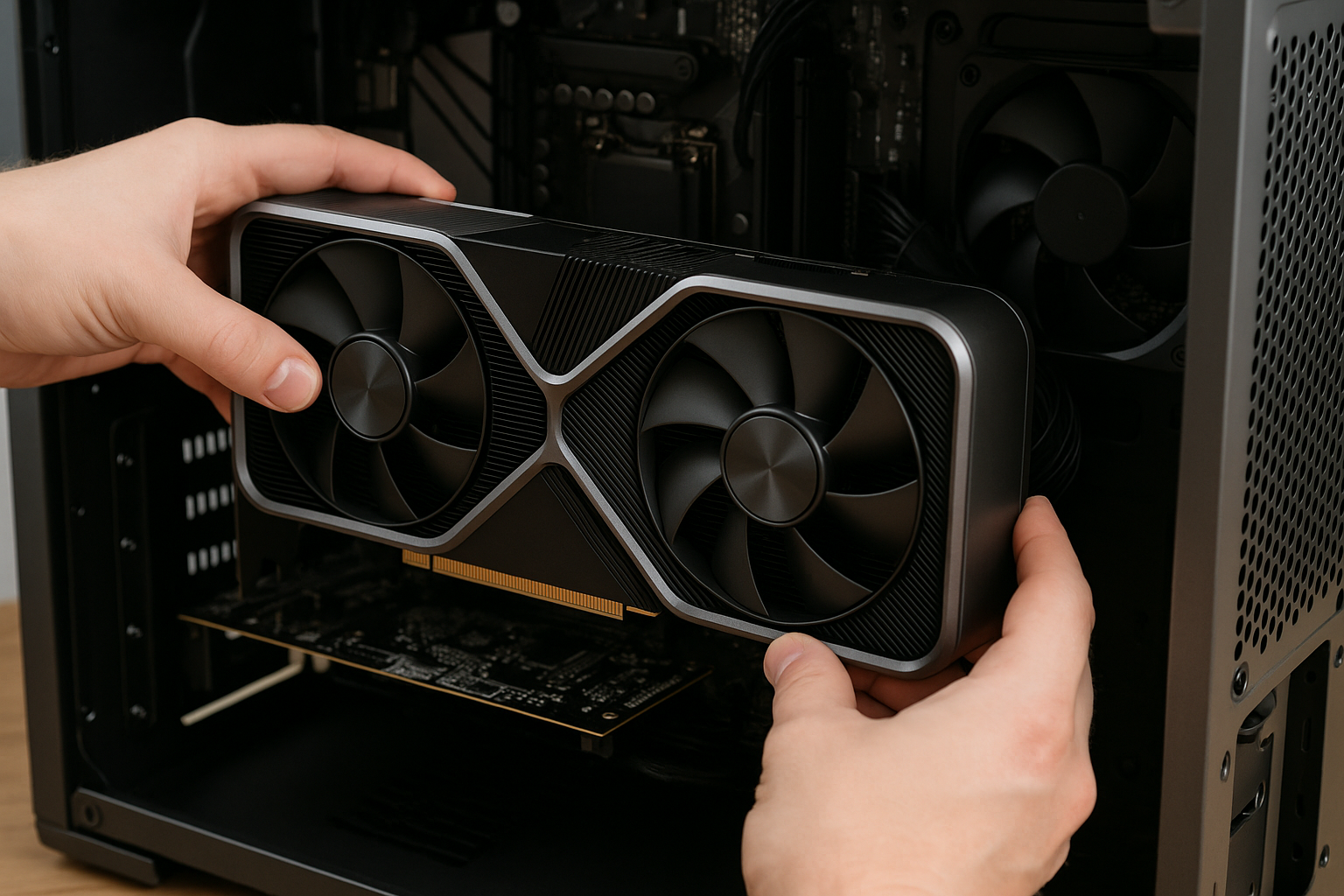Building your own computer is an exciting journey, and one of the most crucial decisions you’ll face is choosing the right graphics card. Whether you’re aiming to play games, edit videos, work with 3D rendering, or even just run multiple monitors efficiently, understanding what to look for in a GPU can make all the difference.
What Is a Graphics Card?
The graphics card, or GPU (Graphics Processing Unit), is responsible for rendering images, video, and visual effects on your screen. There are two main types:
- Integrated graphics: These are built into the CPU or motherboard. They’re suitable for basic tasks like web browsing, video playback, and office work.
- Dedicated graphics cards: These are separate components with their own memory (VRAM). They’re ideal for demanding tasks such as gaming, video editing, graphic design, and 3D modeling.
Know Your Main Purpose
Before diving into specs and prices, define what you need your graphics card for:
- Gaming: Look for a GPU that performs well with modern games, supports high frame rates, and includes technologies like ray tracing and DLSS (for NVIDIA cards).
- Professional work (editing, 3D rendering, design): Choose a card with high VRAM, good CUDA core count (for NVIDIA), and multi-monitor support.
- Everyday use (studying, browsing, watching videos): Modern integrated graphics are often enough.
- Streaming and live content creation: Go for a GPU with hardware encoding support (like NVENC from NVIDIA).
NVIDIA vs. AMD: Which Brand to Choose?
When it comes to dedicated graphics cards, the two major players are:
- NVIDIA: Known for their GeForce GTX and RTX series, offering powerful performance and exclusive features like DLSS and NVENC encoding.
- AMD: Offers the Radeon RX line, often with better price-to-performance ratios and strong multi-threaded rendering.
Both brands offer excellent GPUs — your decision should be based on your budget and software needs.
Key Specs to Consider
Understanding the technical specifications will help you choose a card that matches your needs and system compatibility.
1. VRAM (Video RAM)
- 4GB to 6GB: Suitable for 1080p gaming and light editing.
- 8GB or more: Better for modern games, 1440p or 4K resolution, and professional applications like Adobe Premiere or Blender.
2. Clock Speed
Measured in MHz or GHz, the clock speed affects how fast the GPU processes data. Higher is generally better, but it’s not the only factor — core count and architecture matter too.
3. CUDA Cores (NVIDIA) / Stream Processors (AMD)
These are the “cores” that handle data processing. More cores usually mean better performance, but keep in mind that architecture also plays a big role.
4. Ray Tracing and DLSS (for gamers)
If you’re into immersive, high-end gaming, look for cards with real-time ray tracing (like NVIDIA’s RTX series) and DLSS, which boosts performance with AI-enhanced upscaling.
Consider Compatibility
A powerful GPU won’t help if it doesn’t fit your system. Pay attention to:
- Motherboard compatibility: Most modern GPUs use PCIe x16 slots, but check your board’s version and size.
- Power supply unit (PSU): Check the power requirements of the GPU and ensure your PSU can handle it (in both wattage and connectors).
- Case size: Some high-end cards are very large — make sure your case has enough clearance and proper airflow.
Cooling Solutions Matter
Graphics cards generate heat. Cooling methods include:
- Single-fan GPUs: Smaller and quieter, but less cooling capacity.
- Dual- or triple-fan cards: Better for performance and temperature control, especially for gaming or heavy workloads.
- Water cooling (rare): Found in high-end custom builds, ideal for overclocking and quiet operation.
Recommended GPUs by Use Case
Here are some GPU suggestions based on common usage needs (subject to change as new models release):
Budget Everyday Use
- NVIDIA GT 1030
- AMD Radeon RX 550
Mid-Range Gaming / Light Editing
- NVIDIA GTX 1660 Super
- AMD Radeon RX 6600
High-End Gaming / Streaming / Video Editing
- NVIDIA RTX 3060 / 3070 / 4070
- AMD Radeon RX 6700 XT / 6800
Professional Work (3D, Rendering, CAD)
- NVIDIA RTX 3080 / 4090
- AMD Radeon PRO series
Don’t Overpay for Features You Won’t Use
It’s tempting to go all-in on the most powerful graphics card available, but if you won’t use it to its full potential, you’re wasting money and energy. Focus on what you actually need, not what’s trending in the gaming world.
Final Tips Before Buying
- Check benchmarks: Look at real-world performance reviews on YouTube or benchmarking websites.
- Watch prices: GPU prices fluctuate often — consider tools like PCPartPicker or price alert websites.
- Buy from trusted sources: Avoid used GPUs unless you trust the seller and have a return policy.
Wrapping Up: Your GPU Should Fit Your Real Needs
Choosing the right graphics card is all about balance. It should match your usage, budget, and system. Whether you’re gaming, working, or casually browsing, the ideal GPU will offer stable performance, quiet operation, and long-term value.
Now that you know what to look for, you’re much closer to completing a smart and efficient PC build.
